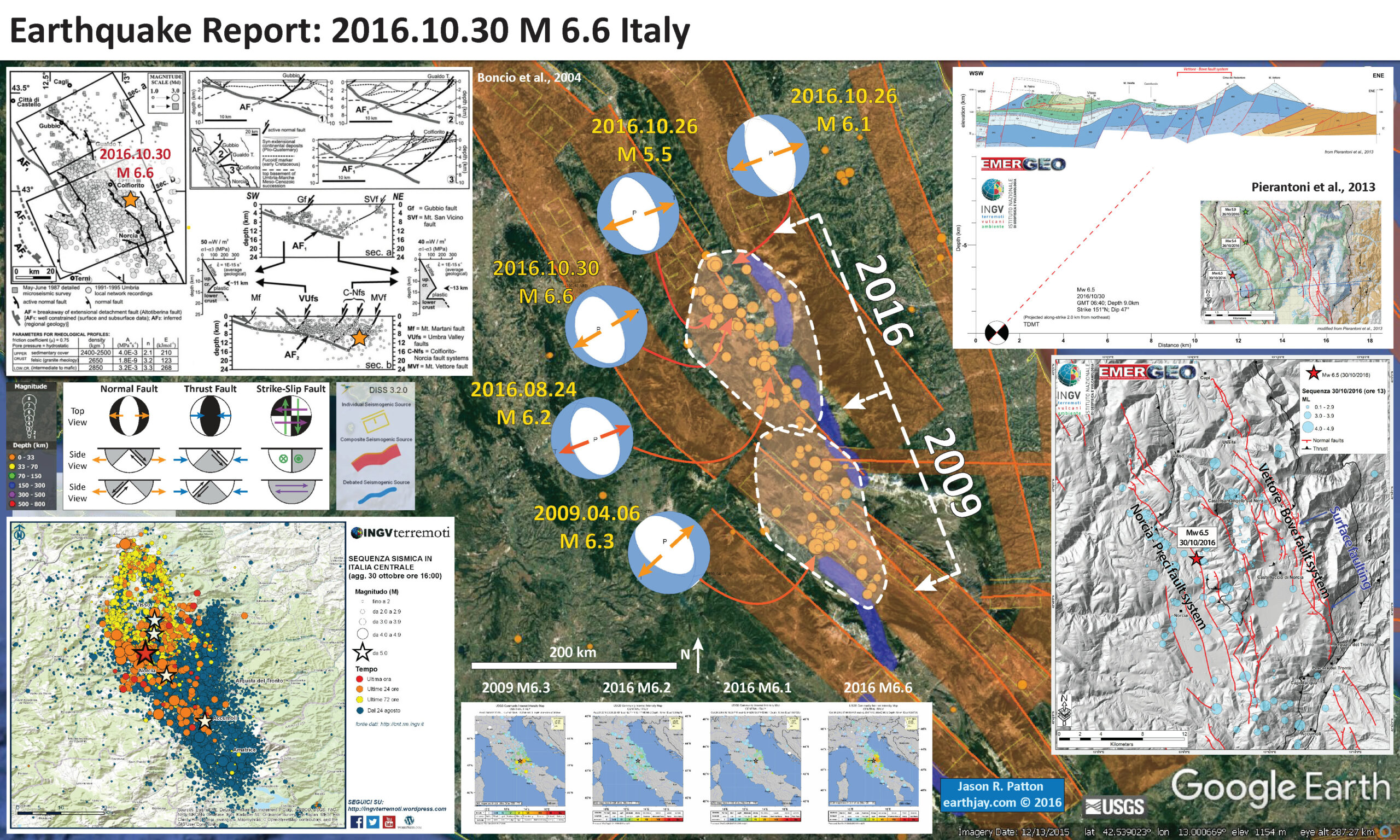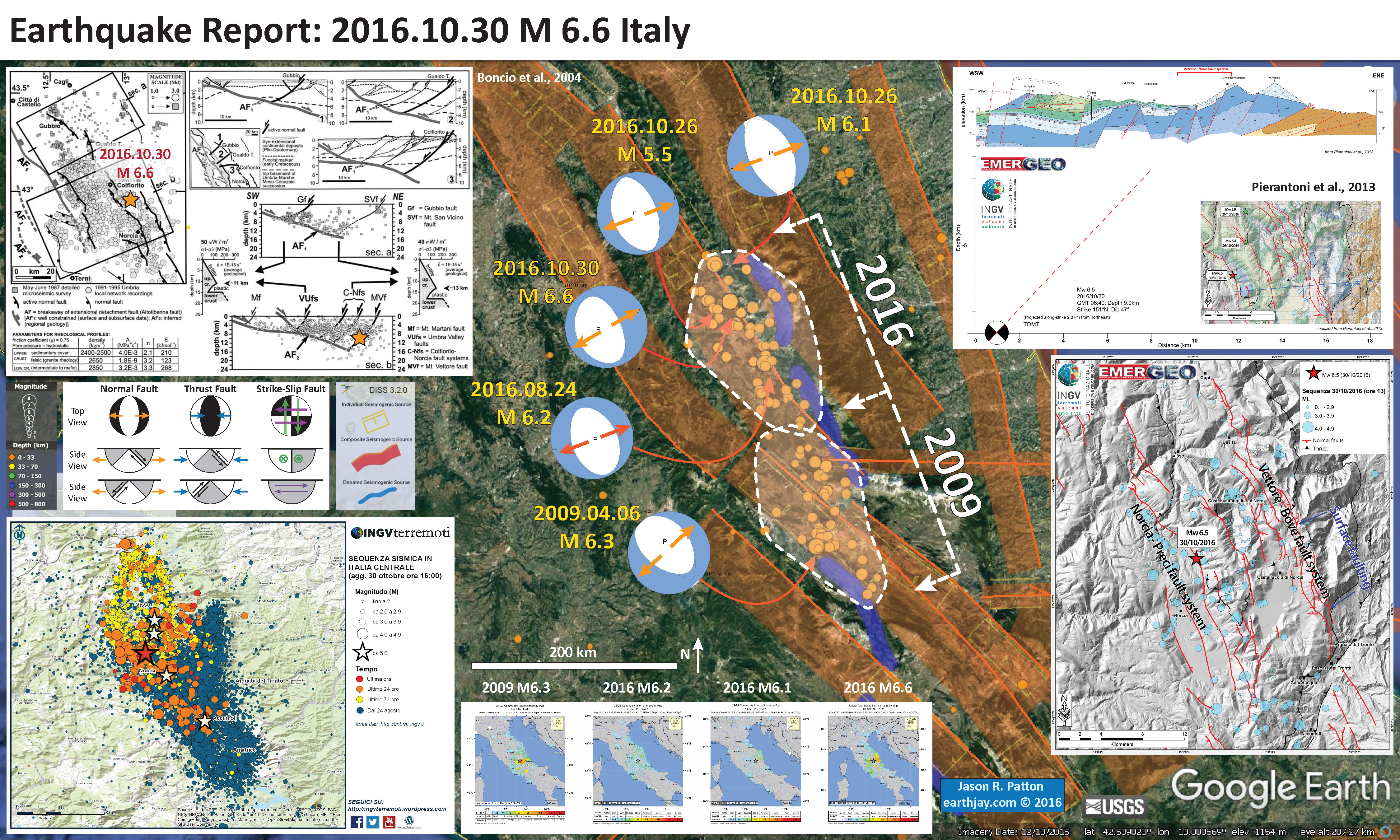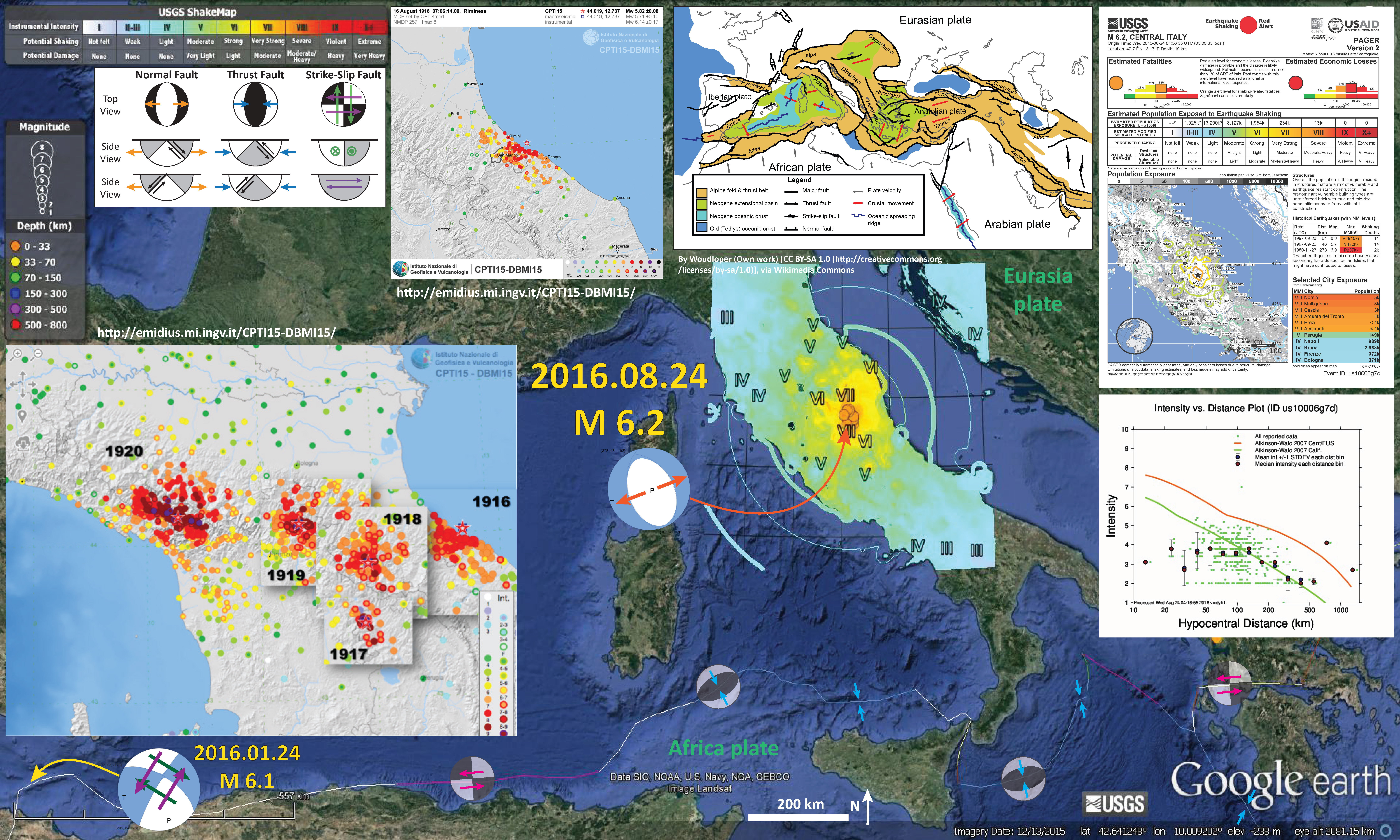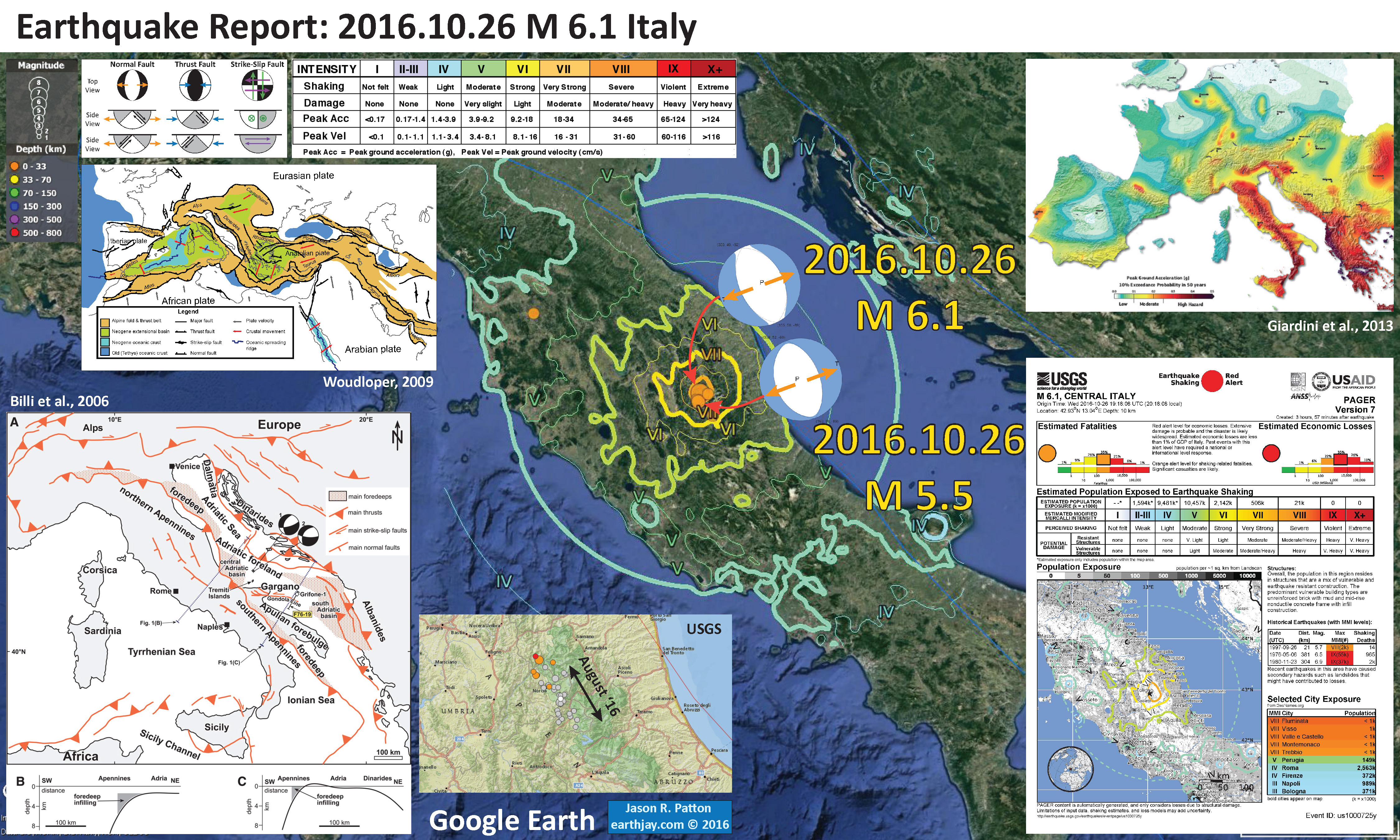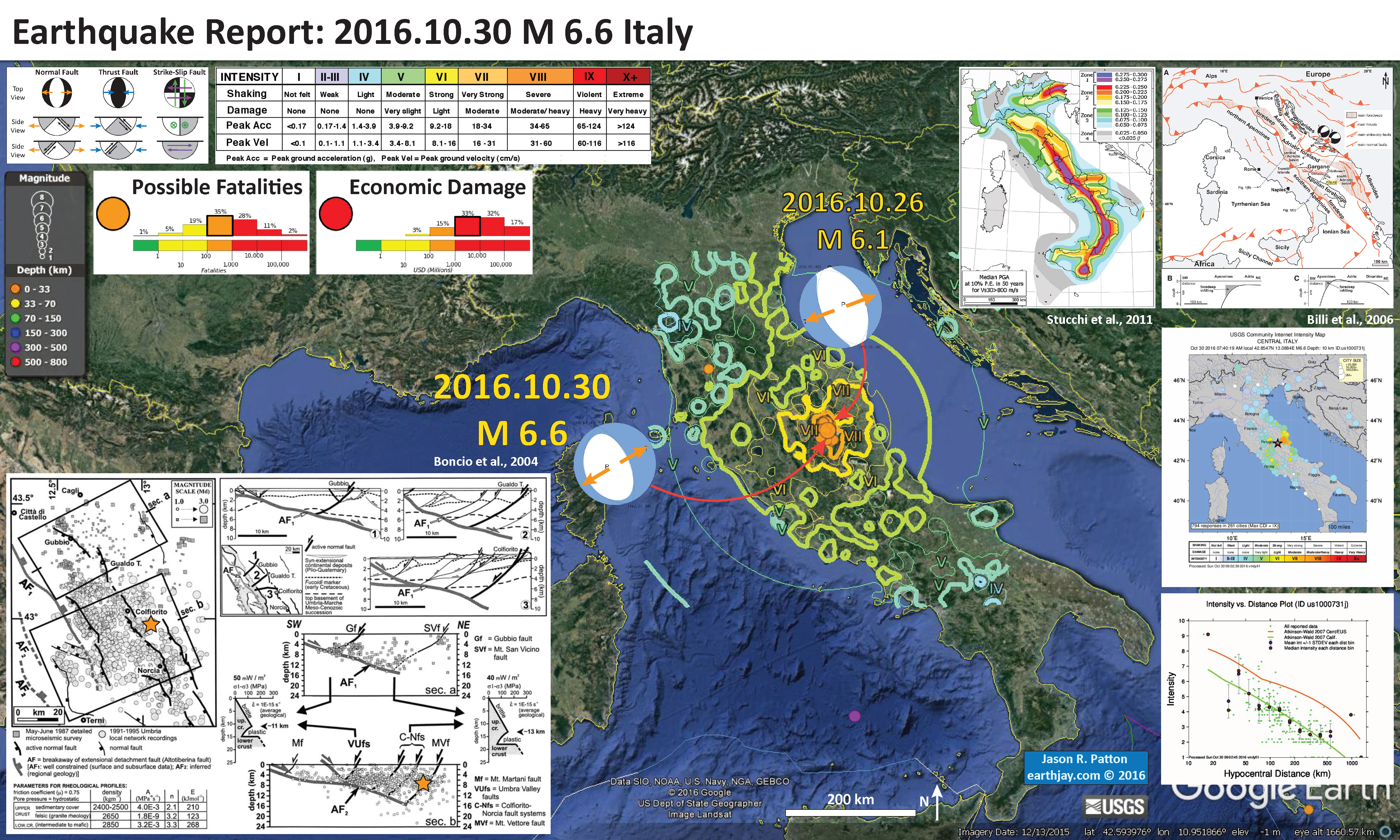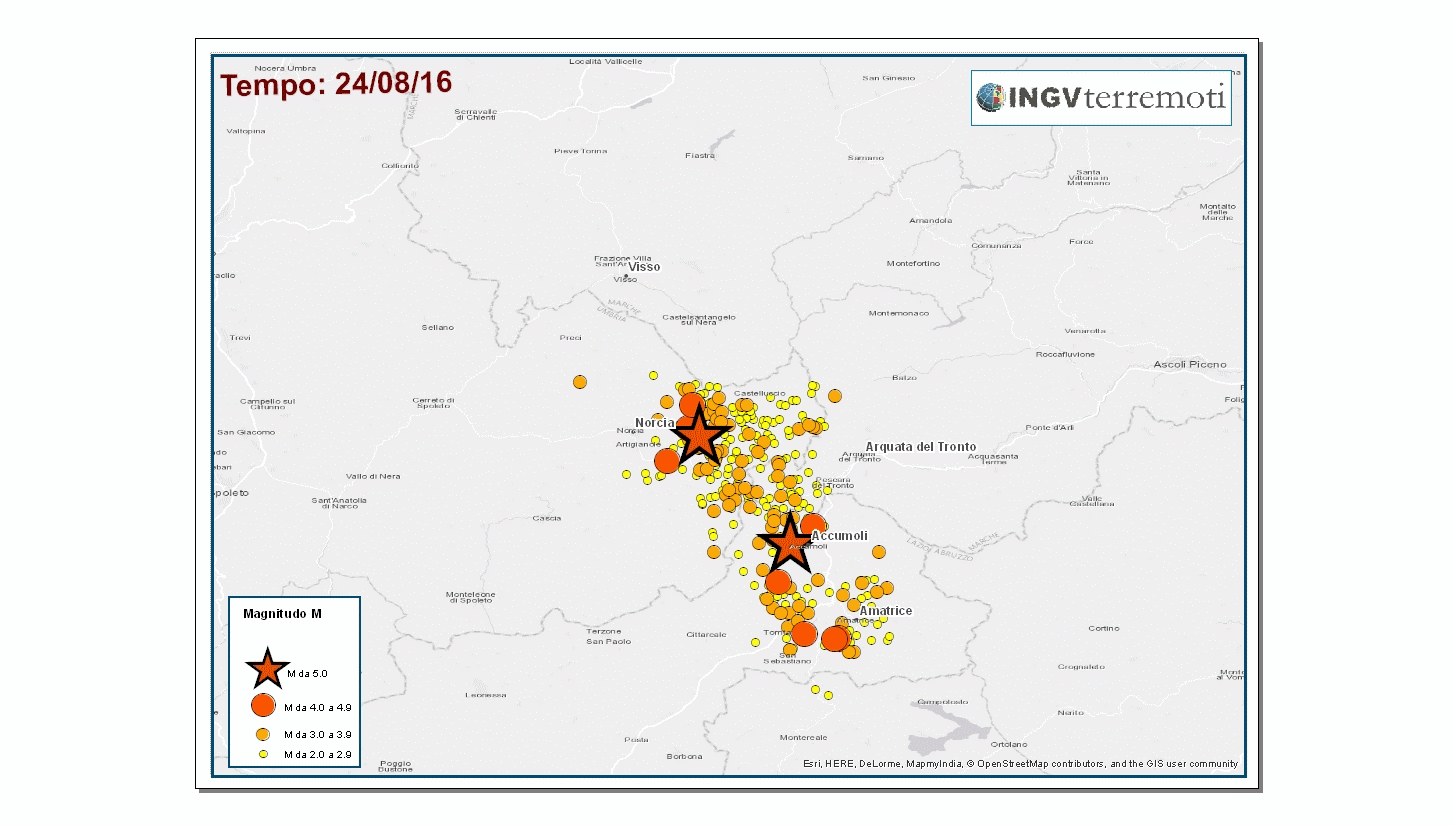Here is an update to the #EarthquakeReport for the M 6.6 earthquake that hit Italy early this morning my time. Ironically, I was preparing a report for earthquakes in the western Pacific for my class when this M 6.6 earthquake hit and I did not notice the USGS email because I was so engaged with the western Pacific report. Here is the interpretive poster for that region over the past week or so.
This region has been experiencing a series of large earthquakes since August 2016, possibly culminating in this M 6.6 earthquake. These earthquakes may load adjacent faults in the region, so this may not be over. Given the series of earthquakes in the region further to the north (from 1916-1920), this may not be over. Stay tuned and stay safe!
The M 6.1 earthquake happened following the M 5.5 earthquake, so people had already been staying outside of their houses. This is thought to be why the casualty number was lower than expected for the M 6.1 earthquake. While the damage estimates are likely to be closer to the bar for both the M 6.1 and M 6.6 earthquakes, the casualty list is also thought to be lower for the M 6.6 earthquake for the same reason.
-
Here are the USGS websites and Earthquake reports for this region of Italy.
- 2009.04.06 M 6.3 USGS website
- 2016.08.24 M 6.2 USGS website and Earthjay Earthquake Report
- 2016.10.26 M 5.5 USGS website and Earthjay Earthquake Report
- 2016.10.26 M 6.1 USGS website and Earthjay Earthquake Report
- 2016.10.30 M 6.6 USGS website and Earthjay Earthquake Report
Below is a poster that shows epicenters from 2008 – 2016. I have included moment tensors for the largest megnitude earthquakes and outlined the region that has had earthquakes in the two periods (2009 & 2016). I also include the fault database from the Instituto Nazionale di Geofisica e Vulcanologia (the Database of Individual Seismogenic Sources, DISS v. 3.; DISS Working Group, 2015). There is a DISS legend to the right of the moment tensor legend. The Mt Vettore fault is considered a “Debated Seismogenic Source” in this database and is the blue fault line on the northern part of the 2016 rupture region.
I placed a moment tensor / focal mechanism legend on the poster. There is more material from the USGS web sites about moment tensors and focal mechanisms (the beach ball symbols). Both moment tensors and focal mechanisms are solutions to seismologic data that reveal two possible interpretations for fault orientation and sense of motion. One must use other information, like the regional tectonics, to interpret which of the two possibilities is more likely. The tectonics of this region has many normal (extensional) faults, which explain the extensional moment tensor.
-
I include some inset figures and maps.
- In the upper left corner is a map that shows seismicity for this region on maps and cross sections (Boncio et al., 2004). I placed orange stars in the approximate location of the October, 2016 earthquakes. These earthquakes happen to appear right on the center of cross section b (the lowermost cross section on the right). It appears that these earthquakes are rupturing along the Mt. Vettore fault.
- In the upper right corner I include a map and cross section compiled by Istituto Nazionale di Geofisica e Vulcanologia (INGV). The map and cross section are from Pierantoni et al. (2013). The cross sectional focal mechanism is located in the approximate location on the cross section. Stars designate the epicentral locations for the recent seismicity on the map. This hypothesis for which structures these earthquakes are appearing on is consistent with my interpretation shown on the Boncio et al. (2004) map and cross section.
- In the lower right corner is another map from INGV that shows the mapped faults in this region and the location of hte 2016.10.30 M 6.6 earthquake, along with other October 2016 seismicity. Observations of potential surface rupture have occurred in the region labeled “Surface faulting.”
- In the lower left corner is another map from INGV that shows epicenters discriminated by time (August = blue, 72 hours = yeallow, 24 hours = orange, 1 hour = red). Note the overlap not seen in my main map. The local seismic network that INGV uses shows many more earthquakes than the global network contributing to the USGS database.
- Along the base of the poster I include “USGS Did You Feel It?” maps for the 4 largest earthquakes plotted on this map.
- Here is my original poster for the M 6.2 earthquake in August. Read more on my initial report here.
- Here is my original poster for this M 6.1 earthquake from a few days ago. Read more on my initial report here.
- Here is my original poster for this M 6.6 earthquake. Read more on my initial report here.
- Here is an animation from INGV that shows seismicity over time. This gif is from here. “This video shows the spatial distribution of simica sequence from 24 August to 31 October.”
- Here is a European Space Agency plot that shows LOS displacement for the 30 Oct earthquake, sourced from here. “Areas in red shifted 15 inches (40 cm) toward the perspective of the satellite, while areas in blue moved away to a similar degree. (Copernicus Sentinel/ESA/CNR-IREA).
- Here is a preliminary visualization of the seismic waves propagating from the M 6.6 earthquake. I include the embedded yt video, as well as an embedded mp4 video.
- Here is the mp4 file to download. (20 MB mp4)
- Here is a great visualization of the seismic waves traveling through the EarthScope Transportable Array of seismometers. Not all these seismometers are being transported as the TS is currrently deployed in Alaska. Other visualizations like this can be found on the IRIS website here.
- Here is the mp4 file to download. (3 MB mp4)
- Here is a video from some hunters.
- Here is the mp4 file to download. (3 MB mp4)
- As a reminder, this region is in a seismically hazardous region of Italy. Here is the 10% probability of exceedance map (for 50 yrs) from INGV.
- This is another view of the seismic hazard in Europe (Giardini et al., 2013).
- Boncio et a. (2004) present a remarkable assessment of the seismic hazard in this region based on a 3-D model for seismogenic sources. I present some of their figures below. I include their original figure captions as blockquotes.
- This map shows a detailed view of the normal faults in the region. Today’s earthquake is in the region shown in box 3, east of the Umbra Valley.
- This map shows an even more detailed and large scale view of the faults and seismicity in this region. Today’s earthquakes align to the north of Norcia, approximately along the cross section labeled “sec B.” The two cross sections are in the lower right part of the figure, with section B the lowermost cross section. Today’s earthquake may be on the AF2, the C-NFs (Colfiorito-Norcia fault systems), or MVf (Mt. Vettore fault). The AF2 fault is a proposed low angle detachment fault. These types of faults are controversial in that there are arguments about whether they are seismogenic or not. This year’s Pacific Cell Friends of the Pleistocene field trip in Panamint Valley presented research results that attempted to address this question. In Panamint Valley there are faults that have similar configurations as these faults in Italy.
- This map shows a smaller scaled view (than the above figure) with focal mechanisms and cross sections (with structural interpretations). Hypocenters are also plotted on these cross sections. Today’s earthquakes are just south of cross section b. (earthquakes happened here in 1997)
Digital elevation model of central Italy with active normal faults of the Umbria-Marche-Abruzzo Apennines and parameters of active stress tensors obtained by inversion of focal mechanisms of background microseismicity (1), aftershock sequences (2, 3, 4, 5) or striated active faults in seismic areas (6); stress data from Brozzetti and Lavecchia (1994), Boncio and Lavecchia (2000a) and Pace et al. (2002a); the stress axes are given as trend (first three numbers) and plunge (last two numbers).
Geological cross sections from seismic reflection profiles across the Gubbio, Gualdo T. and Colfiorito seismic areas (from Boncio et al., 1998; Boncio and Lavecchia, 2000b); epi- and hypocentral distribution of back-ground microseismicity recorded in the Umbria-Marche Apennines and rheological profiles (strength envelopes in critical stress difference, σ1–σ3) built for two different thermal contexts (50 and 40 mW/m2 surface heat flow, see Figure 3 for location); the depth of the brittle-plastic transition on rheological profiles is indicated by arrows; the used rheological parameters are indicated: crustal layering is from DSS data; A (empirical material constant), n (stress exponent) and E (activation energy) are creep parameters; ´ε = longitudinal strain rate (calculated by balancing of a regional geologic section; Figure 5 in Boncio et al., 2000); see text for further details.
Epicentres of the major seismic sequences of the last twenty years (Gubbio, 1984; Colfiorito, 1997; Norcia, 1979; Sangro, 1984) plus three small seismic sequences in the L’Aquila area (1992, 1994 and 1996); seismotectonic sections and rheological profiles built according to the local thermal context. The dashed line (sections ‘a’ and ‘b’) represents the AF low-angle extensional detachment; arrows in seismotectonic sections indicate the maximum depth-extent of the activated seismogenic faults as suggested by the best defined aftershock volume; rheological parameters as in Figure 7; in the southern Abruzzo area, creep strengths for geologic and geodetic longitudinal strain rates are compared (geologic strain rate calculated from data of Galadini and Galli, 2000; geodetic strain rate from D’Agostino et al., 2001); seismological data from Amato et al. (1998); Boncio (1998); Boncio et al. (2004); Cattaneo et al. (2000); De Luca et al. (2000); Deschamps et al. (1984); Ekstrom et al. (1998); Haessler et al. (1988); Harvard CMT database at www.seismology.harvard.edu.
- Billi et al., 2006.
- Boncio, P., Brossetti, F., and Lavecchia, G., 2000. Architecture and seismotectonics of a regional low-angle normal fault zone in central ltaly in Tectonics, v. 19, no. 6, p. 1038-1055.
- Boncio et al., 2004. Defining a model of 3D seismogenic sources for Seismic Hazard Assessment applications: The case of central Apennines (Italy) in Journal of Seismology, v. 8, p. 417-125.
- DISS Working Group (2015). Database of Individual Seismogenic Sources (DISS), Version 3.2.0: A compilation of potential sources for earthquakes larger than M 5.5 in Italy and surrounding areas. http://diss.rm.ingv.it/diss/, Istituto Nazionale di Geofisica e Vulcanologia; DOI:10.6092/INGV.IT-DISS3.2.0
- Galadini, F. and Galli, P., 1999. The Holocene paleoearthquakes on the 1915 Avezzano earthquake faults (central Italy): implications for active tectonics in the central Apennines in Tectonophysics, v. 308, p. 143-170.
- Giardini, D., Woessner, J., Danciu, L., Cotton, F., Grünthal, G., Pinho, R., and Valensise, L.., and the SHARE Consortium, 2013. SHARE European Seismic Hazard Map for Peak Ground Acceleration, 10% Exceedance Probabilities in 50 years, doi: 10.2777/30345, ISBN-13, 978-92-79-25148-1.
- Palumbo et al., 2004. Slip history of the Magnola fault (Apennines, Central Italy) from 36Cl surface exposure dating: evidence for strong earthquakes over the Holocene in Earth and Planetary Science Letters, v. 225, p. 163–176.
- Pierantoni, P., Deiana, G., and Galdenzi, 2013. Stratigraphic and structural features of the Sibillini Mountains (Umbria-Marche Apennines, Italy) in Italian Journal of Geoscience, v. 132, no. 3, p. 497-520 DOI
http://dx.doi.org/10.3301/IJG.2013.08 - Stucci, M., Meletti, C., Montaldo, V., Crowley, H., Calvi, G.M., and Boschi, E., 2011. Seismic Hazard Assessment (2003–2009) for the Italian Building Code in BSSA, v. 101, no. 4, p. 1885-1911.
- Woudloper, 2009. Tectonic map of southern Europe and the Middle East, showing tectonic structures of the western Alpide mountain belt.
